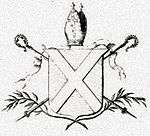Turgot of Durham
Thorgaut or Turgot (c. 1050-1115) (sometimes, Thurgot) was Archdeacon and Prior of Durham, and Bishop of Saint Andrews.[1]
Turgot came from the Kingdom of Lindsey in Lincolnshire. After the Norman conquest he was held as a hostage, but escaped to Norway, where he taught king Olaf psalmody. In about 1074 he returned to England and became a clerk at Jarrow monastery. He then became a monk at Wearmouth, and in 1087 he was appointed prior of the monastery at Durham, from 1093 combining this with the archdeaconry of Durham. He became close to the Scottish court, and between 1100 and 1107 he wrote the life of Malcolm's wife, Saint Margaret of Scotland, at the request of her daughter, Matilda, wife of king Henry I of England.[1]
In 1107 he was elected bishop of St Andrews at the wish of king Malcolm III. Consecration was delayed by ecclesiastical disputes between York and St Andrews, and did not take place until 1 August 1109. According to Symeon of Durham, he found that he could not exercise the office "worthily", and resolved to go to Rome, but he was prevented by the king. He then became ill and was allowed to return to Durham, where he died on 31 August 1115.[1]
Notes
- 1 2 3 Bartlett, Robert (2004). "Turgot (c.1050–1115), author and bishop of St Andrews". Oxford Dictionary of National Biography. Oxford University Press. doi:10.1093/ref:odnb/27831. Retrieved 25 August 2013. (subscription or UK public library membership required)
Further reading
- Dowden, John, The Bishops of Scotland, ed. J. Maitland Thomson, (Glasgow, 1912), pp. 1–3
- Dawson, Christopher, "Religion and the Rise of Western Culture", (Doubleday, 1950), pp. 100
- Veitch, Kenneth, "Replanting Paradise: Alexander I and the Reform of Religious Life in Scotland", in The Innes Review, 52, (Autumn, 2001), pp. 136–166
- "The Life Of St Margaret, Queen Of Scotland". Retrieved 14 March 2011.
| Religious titles | ||
|---|---|---|
| Preceded by Giric or Cathróe |
Bishop of Cell Rígmonaid (Saint Andrews) 1107–1115 |
Succeeded by Eadmer |
| |||||||||||||||||||||||||
